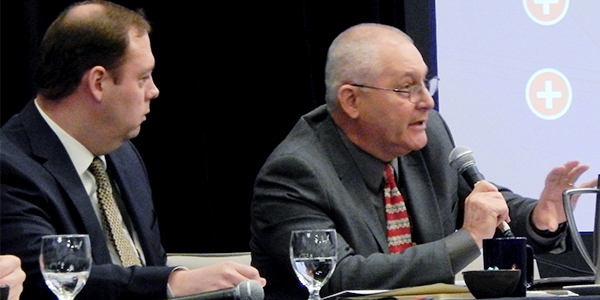By Tom Kleckner
AUSTIN, Texas — Some utilities are taking a hard look at non-wires alternatives (NWAs) given the difficulty and expense of getting transmission projects approved, gaining regulatory sign-off, and siting and building lines.
Speaking last month at Infocast’s ERCOT Market Summit, Hudson Gilmer, founder and CEO of line-monitoring firm LineVision, said his company and others like it offer options in the likely absence of a second competitive transmission build in Texas.
The first such effort — kicked off in the mid-2000s — resulted in 3,600 miles of transmission facilities able to carry 18.5 GW of capacity. The Competitive Renewable Energy Zone buildout, which ended in 2014 and cost $6.8 billion, connected barren and windy West Texas with the state’s eastern and southern urban centers and set the stage for the massive development of renewable energy that was to follow.
Those lines are now full. ERCOT, which operates 90% of the state’s grid, had 23.9 GW of wind capacity at the end of 2019. Another 12.2 GW of wind energy could be added by the end of 2022, while solar capacity could quadruple to nearly 10 GW during that same time.
“What we heard from the wind and solar developers is that transmission is the single-largest obstacle to continue integrated new renewables on the grid,” Gilmer said. “What we’re seeing with new, large transmission projects is that they tend to be fully subscribed. It’s a chicken-or-egg thing. We believe there is an opportunity … to take a fresh look at transmission. Not in the way we’ve built it during the last 75 years, but as a way to unlock additional capacity on the grid.”
Gilmer said he recently learned that typical usage on the average ERCOT transmission line is under 20%.
“That makes me pretty mad,” he said. “If we can use technology to unlock additional capacity on those lines, that makes a difference and can make a project more viable when it suddenly didn’t pencil out.”
LineVision offers continuous monitoring of transmission line conductors to confirm they are performing within their acceptable operating limits. By taking advantage of low-cost sensors, Gilmer said, his company can watch for sagging lines and push out additional capacity when the line cools.
“Not every line is monitored in ERCOT,” he said. “The transmission operator has to make very conservative assumptions about the line.”
Gilmer said topology control, which uses a software-based solution to identify grid reconfiguration opportunities on open relays and alleviate congestion, can offer a similarly less capital-intensive solution to building new high-voltage transmission lines.
Noting that close to half of all congestion in ERCOT is outage-related, he said LineVision advocates a shift in transmission construction.
“Traditionally, we build through towers and wires. Here’s an opportunity to invest in Texas using software and analytics at a fraction of the cost, making the grid much more flexible and reliable and less expensive,” Gilmer said.
Making the Case
David Townley, director of public policy for CTC Global, plugged his company’s advanced conductors. CTC’s conductors use high-strength, lightweight carbon and glass fibers that helps them withstand extreme peak-load conditions and reduce thermal sag.
“By replacing steel with carbon fiber, you’re changing the performance of [the wire’s] steel core, so it doesn’t sag that much,” Townley said. “Less sag allows you to put more current through the line.”
Townley said the conductors have resulted in about a 20 to 60% increase in operating capacity on an existing system, and “up to 100% in emergency situations.”
“Freeing up that capacity gets more out of the existing system,” he said.
“I sleep better at night when I don’t have to worry about how close a conductor is sagging to the ground,” said Jonathan Greene, senior vice president of transmission operations for Lower Colorado River Authority. “Not having to upgrade or replace wire to get 15 to 20 additional feet is a benefit.”
Greene said LCRA has installed advanced conductors in four locations, three of them in river or lake crossings, using 30-year-old existing towers. He said the cooperative has seen increased line ratings but noted that LCRA hasn’t seen that advanced conductors are cost effective for a full line upgrade.
“Advanced conductors are fantastic, but they’re still fairly expensive,” Greene said.
Gilmer, who advocates a shared-cost model, empathized with Greene.
“Regulated utilities need incentives to adopt these technologies. If you alleviate congestion with one of these technologies, you should get to share a percentage of those savings,” Gilmer said. “We’ve been very encouraged by the response we’ve gotten at the federal level and at some state commissions. We’re seeing, especially in the wake of California and the wildfires, an increased awareness of the safety risk for unmonitored lines. We feel like there’s a very compelling return on investment in deploying sensors for situational awareness and anomaly detection.”
Electric Transmission Texas President Kip Fox, whose joint venture between American Electric Power and Berkshire Hathaway Energy was involved in CREZ, posited that NWAs could actually increase returns on transmission lines.
“There’s a lot of downward [regulatory] pressure on returns,” Fox said, voicing an imaginary argument in favor of NWA upgrades. “‘Hey, I’ve made this line more valuable [through NWA]. Why can’t I have a higher return on this line?’”







